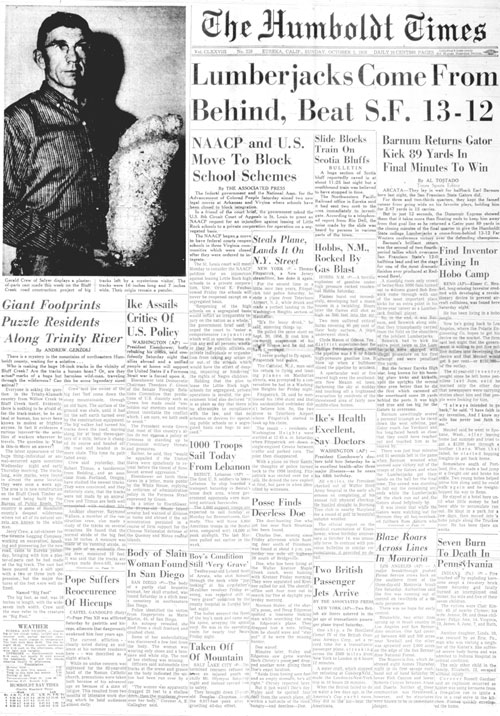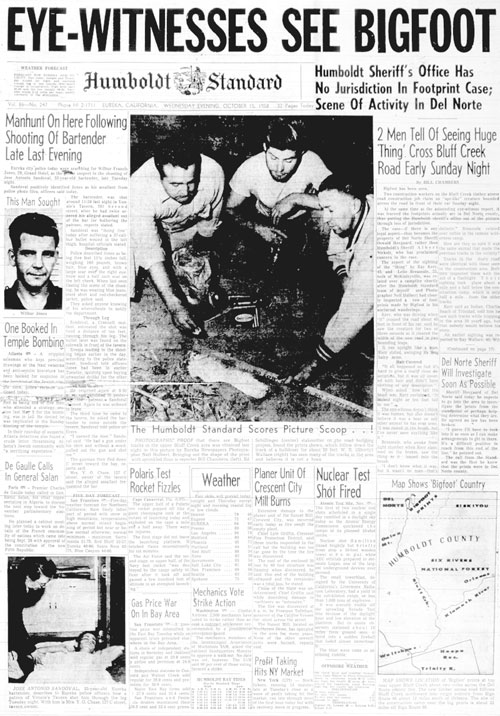Bigfoot Encounters
Birth of Bigfoot
John Driscoll/The Times-Standard
 10/30/2008 -- Maybe it was bad light or bad mushrooms. Maybe it was someone in a stitched-up bear skin creeping up on the bonfire to scare the wits out of his brother. Or maybe it really was a rare primate that wandered near camp in the dark several thousand years ago that caught someone's eye.
10/30/2008 -- Maybe it was bad light or bad mushrooms. Maybe it was someone in a stitched-up bear skin creeping up on the bonfire to scare the wits out of his brother. Or maybe it really was a rare primate that wandered near camp in the dark several thousand years ago that caught someone's eye.
However it happened, Sasquatch was hatched into the human consciousness, long, long ago.
But Bigfoot strode into the picture just 50 years ago this month. Born in the pages of the Humboldt Times by columnist Andrew Genzoli, the word Bigfoot was to become the new operating title for the hairy beast of lore.
In Bluff Creek off the Klamath River this month in 1958, Jerry Crew and his road construction crew found tracks of a Sasquatch, the story goes. Crew made a plaster cast of the impressions, and brought them into the Times on Oct. 4.
Genzoli recorded that the men called the creature Big Foot.
”There is a mystery in the mountains of northeastern Humboldt County, waiting for a solution ... Who is making the huge 16-inch tracks in the vicinity of Bluff Creek?” Genzoli wrote in the front page story below a classic photo of Crew with a plaster cast of the big foot. “Are the tracks a human hoax? Or, are they actual marks of a huge but harmless wild-man, traveling through the wilderness? Can this be some legendary sized animal?”
It's difficult to know how seriously Genzoli took the story, and he raises some questions about the claim and introduces skeptics to balance the piece.
Then things started getting weird. A $1,000 reward was offered to anyone who could explain the mystery, which was, proclaimed the Times' sister paper the Humboldt Standard, either a hoax or “a mentally deficient, over-grown boy gone wild.”
 Only 10 days later, it was Times reporter Bill Chambers on the case. Chambers reported that the Humboldt County Sheriff's Office was convinced they had the man responsible for the footprints in Bluff Creek, and that he would confess.
Only 10 days later, it was Times reporter Bill Chambers on the case. Chambers reported that the Humboldt County Sheriff's Office was convinced they had the man responsible for the footprints in Bluff Creek, and that he would confess.
But when construction worker Ray Wallace -- the supposed hoaxer -- was contacted by the Times about the allegations, he reacted angrily.
”I'm not going in. If they want to put out a warrant I'm going to sue them for slander -- and I won't fool around about it!” Wallace said. “If they think they're going to make a laughing stock out of me, they've got another thing coming.”
Wallace's brother W.R. “Shorty” Wallace insisted that no one would work all day in the Bluff Creek country and then run around planting footprints.
The Oct. 15 Times edition featured a huge photo spread, with Chambers reporting that “Bigfoot has been seen.” Two construction workers had seen a Sasquatch and told him all about it. The Standard on Oct. 16 said the witnesses were, “Two husky construction workers with good eyesight,” in an effort to eliminate doubt.
Now look, anyone who's ever been the victim of a good hoax knows just how seriously it can be taken by its perpetrators. Things take on an overblown quality. Characters involved in successful hoaxes play different roles to satisfy the victim or victims who take different approaches to interpreting a mystery.
Shorty Wallace's explanation that no one would stomp around making footprints after work is obvious bunk in hindsight. His role likely was to instill doubt. Ray Wallace's vehement denial of the allegation -- even threatening to go to the courts -- was likely meant to make him the untouchable martyr.
The husky construction workers with good eyesight were probably enlisted to play the role of true believers. Jerry Crew provided the ever-important introduction of evidence, to get the ball rolling and feel out initial reactions.
We now know the whole thing was a hoax -- or a brash attempt to claim credit for one. Late in 2002, Ray Wallace died at the age of 84 in Washington. But he didn't take Bigfoot to the grave with him; he had spilled his guts to a few members of his family. The man who insisted he'd “sue the - for slander” had confessed to being the original Bigfoot hoaxer, his son and nephew told the Seattle Times.
What was surprising was what the Times-Standard -- that descendant of the original Bigfoot newspapers -- learned upon news of Wallace's death. The Times-Standard called June Beal, wife of deceased Times editor L.W. “Scoop” Beal, to find out if she knew anything about it. June Beal was a perpetually pleasant person who until shortly before her death in July 2007 visited the newsroom regularly to chat.
June Beal told the Times-Standard that she'd been mum on the topic for nearly five decades, even as she watched it spiral out of control. Finally, with Wallace's death, she was willing to share her secret.
”They were in on this hoax,” June Beal said of her husband and Wallace. “It was just a fun thing and the fun got out of hand.”
It certainly explains Chambers' almost complete lack of skepticism in his reporting at the time. It also shows how newspapers -- especially at the time -- had an incredible influence on events, as Bigfoot became infused into the minds of the adventurous, the scared and the gullible.
Bigfoot made a massive resurgence when Roger Patterson supposedly filmed a Bigfoot near Bluff Creek in 1967. That footage is still some of the most relied on for both skeptics and believers regarding the existence of Sasquatch.
To be sure, the Sasquatch and the wild man have long been a part of myth and legend. And as Idaho State University researcher Jeff Meldrum -- a primary advocate of the existence of the man-beast -- said, not all the footprints cast in plaster over the years could possibly have been hoaxes.
This goes back to the rule for misinformation and general trickery: Just because you made it up, doesn't mean it isn't true.
Published in the Times-Standard, Eureka, California's North Coast... Halloween, 2008
Back to Bigfoot Encounters Main page
Back to Newspaper & Magazine Articles
Back to Bigfoot Encounters "What's New" page
Portions of this website are reprinted and sometimes edited to fit the standards of this website
under the Fair Use Doctrine of International Copyright Law
as educational material without benefit of financial gain.
http://www4.law.cornell.edu/uscode/17/107.html
This proviso is applicable throughout the entire Bigfoot Encounters Website.